

| The Click Beetles (Elateridae) of Nottinghamshire |
| Relatively easy to distinguish by their shape, Nottinghamshire certainly has it's fair share of the 65 species of Click Beetle (Elateridae) currently known from the UK. Much of the county's wealth of species (for its relatively northern geographical positioning) is completely due to the ancient Oak woodland of Sherwood Forest. | ||
| .... |
| Sherwood Forest is
particularly notable for the number of rare beetles.
Among these, are several nationally rare Click Beetles.
Some are illustrated here,
but the main aim of this page, is to (hopefully) continue
to fill another gap in Nottinghamshire's online natural
history resources. Click Beetles (Elateridae) get their name from their ability to flick themselves upright should they fall onto their backs, and is frequently used as a defence mechanism when the beetle feels threatened. They are able to do this by flexing a well developed joint between the first and second thoracic sternites and this ability to flick themselves out of a plastic pot, brings great delight to children on organised minibeast hunts. |
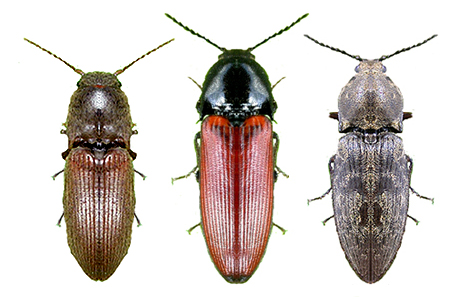 |
|
| .... | ||
| Click Beetles
make an interesting subject for the naturalist wishing to
broaden their interests by venturing into coleoptera
study. Although the correct identification of some
species can be difficult, many species can be identified
from good quality photographs, especially with a number
of photographs taken from a variety of different angles. Most Click Beetles are quite drab in overall colouration and often either brown or black. From May onwards and continuing throughout the Spring, Athous haemorrhoidalis and the much smaller Agriotes pallidulus (both two shades of brown) can be found resting on low vegetation and various coarse grasses. These are probably the most common of the county's Click Beetles and will occur in most grassy areas and along roadside verges. Both are worth learning to identify early on and Umbellifer flowers are always worth checking for both species. |
||
| ....... |
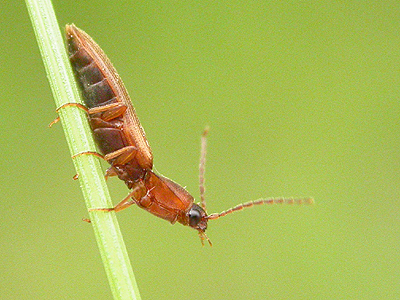 |
Some
notable Nottinghamshire species But there are some Click Beetles that are exceptions to the drab, brown or black rule of colouration and the striking red and black Ampedus are undoubtedly some of the most colourful found in the UK and a number of them have national rarity status. Nottinghamshire has five species of Ampedus, but there have been no records of Ampedus cinnabarinus from Nottinghamshire in well over a century and its doubtful if it still occurs here anymore. Unfortunately the remaining four Ampedus are rather uncommon and in Nottinghamshire are restricted to the Sherwood Forest area. Most of them can be found easily enough, with a little patience, but it usually takes some searching before any degree of success is met with. Nottinghamshire's newest Click Beetle, seems to be Oedostethus quadripustulatus, which was recorded from Besthorpe (Barnes, C.) in 2017 and then turned up on several occasions from a field of Rye Grass at Gedling in 2020. |
|
| ....... | ||
| A predominantly dark, almost black species, Oedostethus
quadripustulatus is attractively marked with four
distinct yellow patches/spots on the elytra, but another
particularly stunning Click Beetle is Ctenicera
cuprea, which is a large and beautifully coloured
Elaterid. In Nottinghamshire Ctenicera cuprea is
another species with an apparently restricted range.
Recent records have come from Clumber Park in 2011 (Brash, P.), the
Nottinghamshire Wildlife Trust's Rainworth Heath NR in
2014 and 2016 (Pendleton, T.A. and Pendleton, D.T.) and from
Nottingham University's Jubilee Campus in 2017 (Dutton, A.). And then, somewhat out of the
blue, Ctenicera
pectinicornis was a major surprise when it sat at the top of a
grass stem in May 2020 (Pendleton, T.A.). Species for which there are no recent records There are a number of Click Beetles in the following list, for which there appear to be no modern (post 1970) records. We could find no records of Calambus bipustulatus, Cidnopus aeruginosus, Adrastus rachifer, Ampedus cinnabarinus and Procraerus tibialis since the early 1900's. There is an isolated historical record of Ischnodes sanguinicollis, listed in 'Appendix A "List of species of conservation concern in Nottinghamshire' of the Nottinghamshire Local Biodiversity Action Plan, which we cannot find any trace of elsewhere and think might be doubtful. |
||
| ....... | ||
| Nottinghamshire's current Elateridae species list | ||
| Species shown with a red asterisk, are believed known from historical records only * | ||
| ... |
| AGRYPNUS Eschscholtz, 1829 |
| Agrypnus murinus (Linnaeus, 1758) |
| ....... |
| HYPNOIDUS Dillwyn, 1829 |
| Hypnoidus riparius (Fabricius, 1792) |
| ....... |
| ACTENICERUS Kiesenwetter, 1858 |
| Acternicerus sjaelandicus (Müller, O.F., 1764) |
| ....... |
| CTENICERA Latreille, 1829 |
| Ctenicera cuprea (Fabricius, 1775) |
| Ctenicera pectinicornis (Linnaeus, 1758) |
| ....... |
| CALAMBUS Thomson, C.G., 1859 |
| Calambus bipustulatus (Linnaeus, 1767) *. |
| ....... |
| APLOTARSUS Stephens, 1830 |
| Aplotarsus incanus (Gyllenhal, 1827) |
| ....... |
| PROSTERNON Latreille, 1834 |
| Prosternon tessellatum (Linnaeus, 1758) |
| ....... |
| SELATOSOMUS Stephens, 1830 |
| Selatosomus aeneus (Linnaeus, 1758) |
| ....... |
| CIDNOPUS Thomson, C.G., 1859 |
| Cidnopus aeruginosus (Olivier, 1790) * |
| ....... |
| KIBUNEA Kishii, 1966 |
| Kibunea minuta (Linnaeus, 1758) |
| ....... |
| DENTICOLLIS Piller & Mitterpacher, 1783 |
| Denticollis linearis (Linnaeus, 1758) |
| ....... |
| ATHOUS Eschscholtz, 1829 |
| Athous haemorrhoidalis (Fabricius, 1801) |
| Athous vittatus (Fabricius, 1792) |
| Athous subfuscus (Müller, O.F., 1764) |
| Athous bicolor (Goeze, 1777) |
| Athous campyloides (Newman, 1833) |
| ....... |
| STENAGOSTUS Thomson, C.G., 1859 |
| Stenagostus rhombeus (Olivier, 1790) |
| ....... |
| HEMICREPIDIUS Germar, 1839 |
| Hemicrepidius hirtus (Herbst, 1784) |
| ....... |
| ADRASTUS Eschscholtz, 1829 |
| Adrastus pallens (Fabricius, 1792) |
| Adrastus rachifer (Fourcroy, 1785) * |
| ....... |
| AGRIOTES Eschscholtz, 1829 |
| Agriotes acuminatus (Stephens, 1830) |
| Agriotes lineatus (Linnaeus, 1767) |
| Agriotes obscurus (Linnaeus, 1758) |
| Agriotes pallidulus (Illiger, 1807) |
| Agriotes sputator (Linnaeus, 1758) |
| ....... |
| DALOPIUS Eschscholtz, 1829 |
| Dalopius marginatus (Linnaeus, 1758) |
| ....... |
| AMPEDUS Dejean, 1833 |
| Ampedus balteatus (Linnaeus, 1758) |
| Ampedus cardinalis (Schiødte, 1865) |
| Ampedus cinnabarinus (Eschscholtz, 1829) * |
| Ampedus pomorum (Herbst, 1784) |
| Ampedus quercicola (du Buysson, 1887) |
| ....... |
| PROCRAERUS Reitter, 1905 |
| Procraerus tibialis (Lacordaire, 1835) * |
| ....... |
| SERICUS Eschscholtz, 1829 |
| Sericus brunneus (Linnaeus, 1758) |
| ....... |
| MELANOTUS Eschscholtz, 1829 |
| Melanotus castanipes (Paykull, 1800) |
| Melanotus villosus (Geoffroy in Fourcroy, 1785) |
| OEDOSTETHUS LeConte, 1853 |
| Oedosthethus quadripustulatus (Fabricius, 1792) |
| ....... |
| Species photographs | ||||
| Ctenicera
cuprea (Fabricius,
1775) |
Ctenicera pectinicornis
(Linnaeus, 1758) |
|||
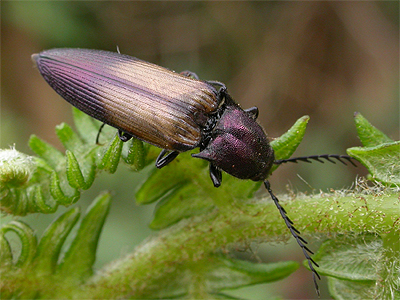 |
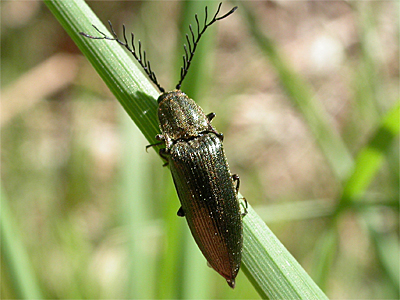 |
|||
| Aplotarsus
incanus (Gyllenhal,
1827) |
Prosternon
tessellatum (Linnaeus, 1758) |
|||
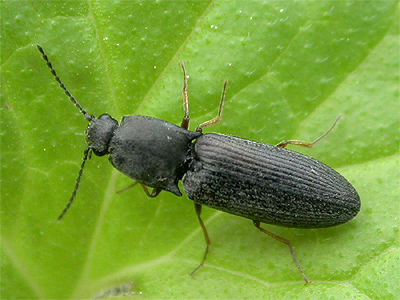 |
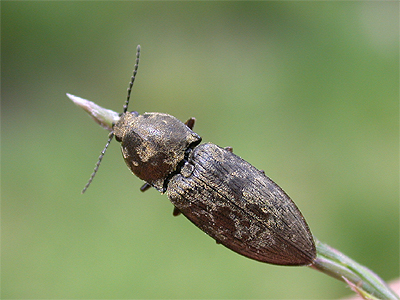 |
|||
| Selatosomus
aeneus
(Linnaeus,
1758) |
Kibunea
minuta (Linnaeus, 1758) |
|||
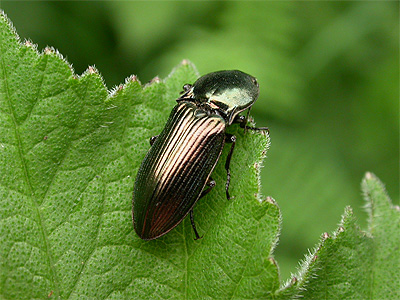 |
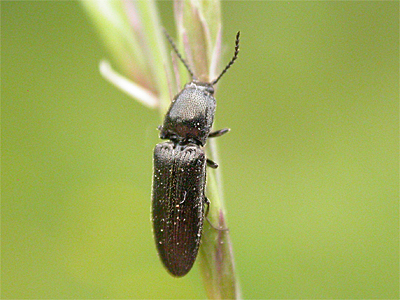 |
|||
| Denticollis
linearis (Linnaeus, 1758) |
Athous
haemorrhoidalis (Fabricius, 1801) |
|||
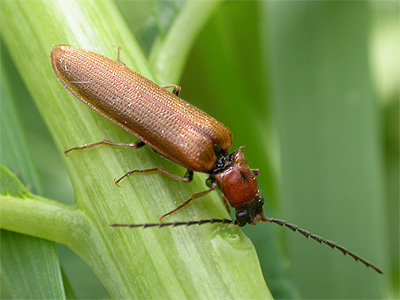 |
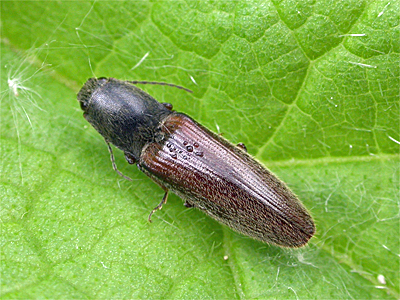 |
|||
| Athous
bicolor (Goeze, 1777)
|
Stenagostus
rhombeus (Olivier,
1790)
|
|||
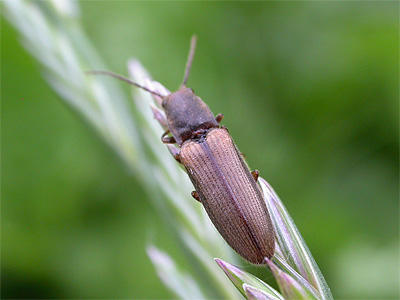 |
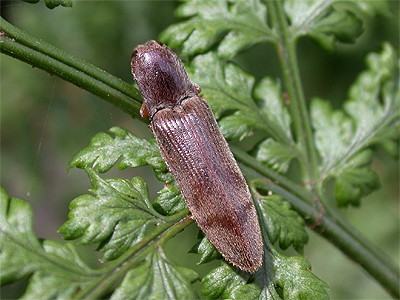 |
|||
| Hemicrepidius
hirtus (Herbst,
1784) |
Agriotes acuminatus
(Stephens, 1830) |
|||
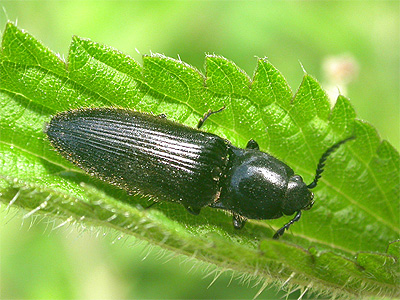 |
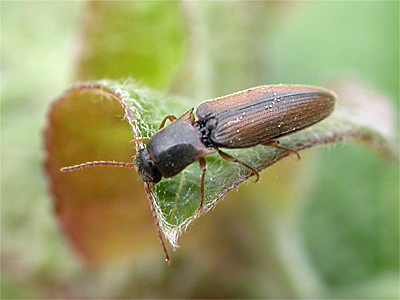 |
|||
| Agriotes
lineatus (Linnaeus,
1767) |
Agriotes
obscurus (Linnaeus,
1758) |
|||
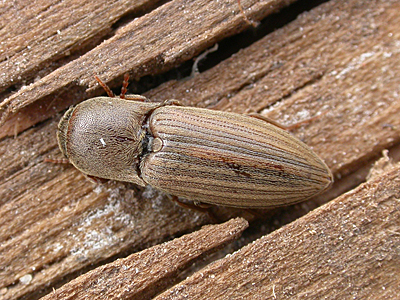 |
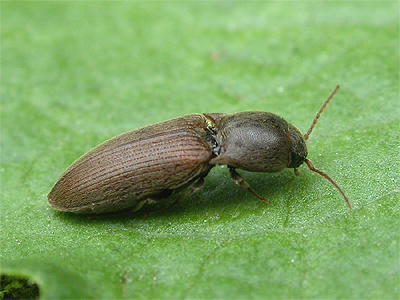 |
|||
| Agriotes
pallidulus (Illiger, 1807) |
Agriotes
sputator (Linnaeus, 1758) |
|||
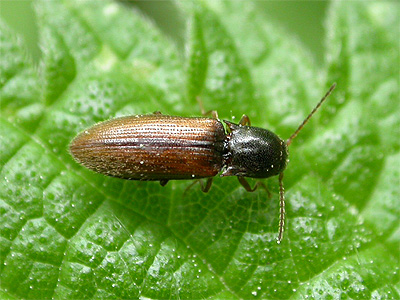 |
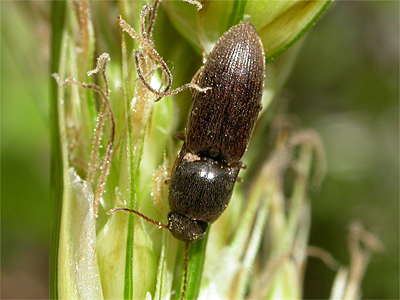 |
|||
| Dalopius
marginatus (Linnaeus, 1758) |
Ampedus
balteatus (Linnaeus, 1758) |
|||
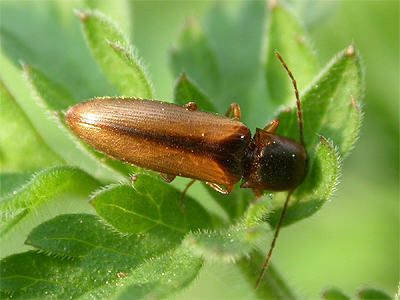 |
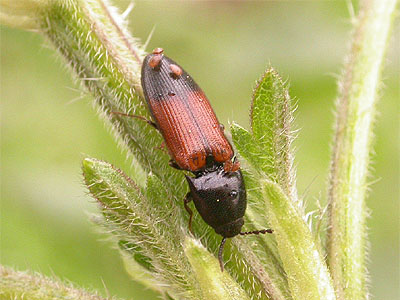 |
|||
| Ampedus
cardinalis (Schiödte, 1865) |
Ampedus
pomorum
(Herbst,
1784) |
|||
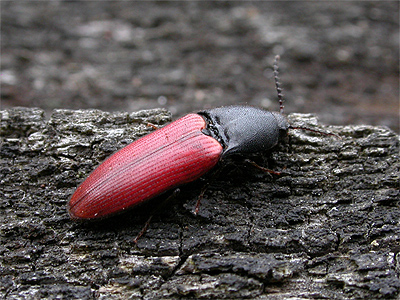 |
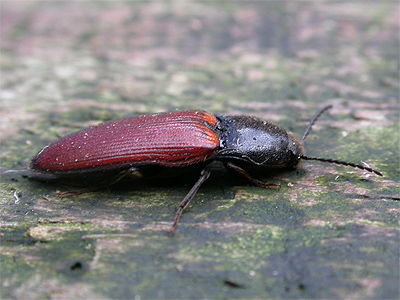 |
|||
| Ampedus
quercicola (du Buysson, 1887) |
Melanotus
castanipes (Paykull, 1800) |
|||
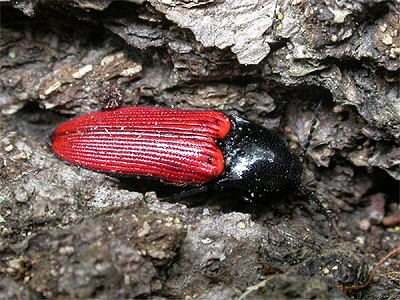 |
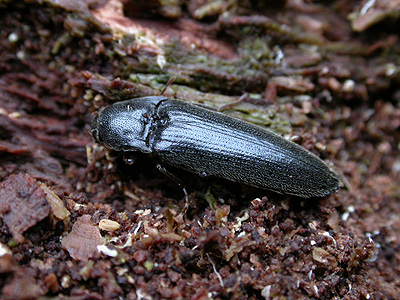 |
|||
| Melanotus
villosus
(Geoffroy
in Fourcroy, 1785)
|
Oedostethus quadripustulatus
(Fabricius, 1792) |
|||
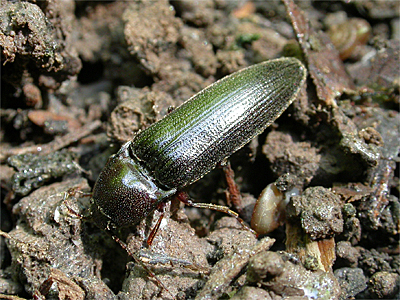 |
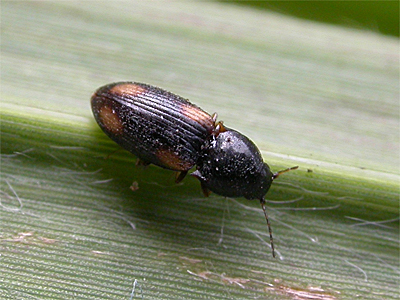 |
|||